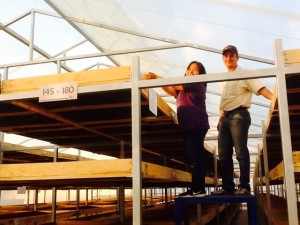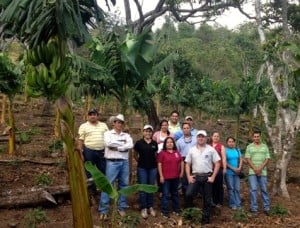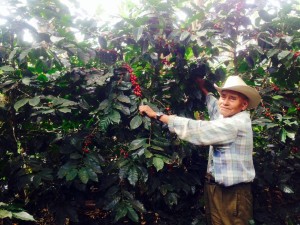Last week my coworker, Claudia Rocio Gomez, and I set out on our annual trip to Honduras, where we met with cooperatives, evaluated their harvests, cupped lots, oversaw milling, and offered technical support. Honduras, which surpassed Guatemala in 2011 as the largest exporter of coffee in Central America, is an emerging specialty coffee producing country and an important supplier to many roasters in the U.S. However, last year’s Roya outbreak hit Honduras hard: 25 percent of the country’s harvest was lost, and the livelihoods of many smallholder coffee farmers were threatened. Furthermore, Roya affected not only production, but also taste—when we cupped Honduras coffees on a supply trip last season, we found Roya’s distinct woody, peanut-y profile.
 With those memories lingering in our minds, we were wary of finding Roya profiles again on our recent visit. However, we were pleased to find that this year, across the board, Honduran coffees are showing improved quality. In spite of the outbreak, they are clean coffees, with flavor and strength that match Honduras’ unique, traditional cup profile.
With those memories lingering in our minds, we were wary of finding Roya profiles again on our recent visit. However, we were pleased to find that this year, across the board, Honduran coffees are showing improved quality. In spite of the outbreak, they are clean coffees, with flavor and strength that match Honduras’ unique, traditional cup profile.
This means that Honduran farmers’ quick response to Roya is paying off. With regional and international support, including our own Roya Recovery Initiative, they have been taking good care of their farms, applying many rounds of rich fertilizer and maintaining other good agricultural practices. On our visit we noticed the strength of the producer organizations, who have emerged stronger in this time of crisis. They are managing their supply well and are staying very conscious of cup quality—preserving heirloom varietals, separating lots, cupping for quality control, providing technical assistance to their members, and preserving quality all the way to port.
Honduras still faces many challenges with Roya, and production is down 35 percent across the country this year. But the quality showing in the cup gives us hope that Honduras will emerge stronger in the coming years. Below are updates from a few of the cooperatives we met with during our visit, to give you insight into the 2013-14 harvest season in Honduras.
Combating Roya at the Regional Level
 To visit the Cosagual cooperative in the department of Lempira, we drove four hours down a dirt road, with spectacular views of three different volcanos. The last two harvests at Cosagual have been very difficult because of the Roya outbreak. The co-op experienced a 50 percent loss in production volume during the 2012-13 harvest. The current 13-14 harvest was less badly hit, with only a 20 percent loss. This is partially due to the measures Cosagual has taken to recover: The cooperative has two tecnicos teaching members how to combat Roya with integrated farm management, shade control, and renovation, and Cosagual is seeking financing for renovation programs.
To visit the Cosagual cooperative in the department of Lempira, we drove four hours down a dirt road, with spectacular views of three different volcanos. The last two harvests at Cosagual have been very difficult because of the Roya outbreak. The co-op experienced a 50 percent loss in production volume during the 2012-13 harvest. The current 13-14 harvest was less badly hit, with only a 20 percent loss. This is partially due to the measures Cosagual has taken to recover: The cooperative has two tecnicos teaching members how to combat Roya with integrated farm management, shade control, and renovation, and Cosagual is seeking financing for renovation programs.
The co-op has also made an agreement with other coffee cooperatives in the area and the regional government to work on Roya prevention because, as some Cosagual members pointed out to me, there is no point in working to prevent Roya if their neighbors let the disease run rampant. Working collectively as a region, they can more effectively minimize the impact of the disease.
Organic fertilizer for healthy plants
Next up, we visited Cocafelol, a gem of a cooperative with outstanding quality FTO coffees, a micro-lot program, strong organizational management, and a solid investment in infrastructure.
Cocafelol has an excellent fertilizer plant that is very productive, producing 20,000 quintales of organic compost and 60,000 liters of liquid fertilizer each harvest. The cooperative subsidizes 50 percent of the cost of the fertilizer to its members, charging them $1.50 per bag. This is extremely cost-effective for Cocafelol members, and as a result of the subsidy they are applying fertilizer more regularly. The health of their plants shows in the cup—their coffee has notes of honey, sugar cane, and cinnamon, with a good balance and a juicy acidity.
Commitment to Quality

This harvest season RAOS showed growth in its coffee processing, lot preparation, and management. The cooperative's team of directors, cuppers, and tecnicos are proving themselves dedicated to quality and transparency. RAOS' dry mill has undergone recent renovations and now has a guardiola (which dries coffee during processing) powered by parchment husks. The cooperative has developed a focused program of lot separation to ensure quality and has also instituted strict processes for the preparation of its lots.
I had the privilege of visiting the farm of one of RAOS' founding members, Señor Toribio Vasquez. Situated at 1660 meters above sea level, Señor Toribio's farm is a little more then one hectare, on which he and his family grow coffee. Only 10 percent of his coffee was affected by Roya this harvest season. Señor Toribio's farm is a perfect example of diversification: He grows alternative crops like plantains, potatoes, lettuce, cabbage, carrots, and peaches, all of which he brings to market.
Interested in this year's coffee from Honduras?
While on this trip, we discovered some delicious lots that were too good to pass up. Sustainable Harvest® is currently offering lots from Honduras with a wide range of cup profiles. To learn more about our Honduran coffee offerings for this harvest, please contact trade@sustainableharvest.com.
Isabel Cerqueda is a Quality Specialist and a certified Q-Grader. Claudia Rocío Gomez is a Coffee Quality Manager and a certified Q-Grader and Instructor. Click here to meet our entire supply team.



.png)
